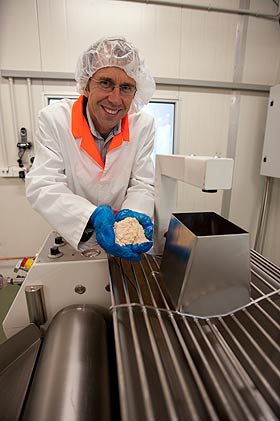
 Pat Silcock
Pat Silcock
He and his colleagues have been using science to help companies create longer-lasting, better tasting, safer products and accelerate new product development.
Test-tasting chocolate doesn't sound like a tough task, but it's more difficult than it might seem.
Pat Silcock, manager of the Department of Food Science's Product Development Research Centre, has been trying to understand just what makes chocolate, well, yummy.
In scientific terms, that's analysing what gives chocolate the sensory properties consumers want and it's part of helping confectionery giant Cadbury improve its product.
Silcock and Food Science head Associate Professor Phil Bremer have been using science to help companies create longer-lasting, better tasting, safer products and accelerate new product development.
"The idea is to understand the process and the ingredients, and how they work together to give rise to the important qualities of the final product," says Silcock. "If we can model that, then developing new products becomes far less risky." Many manufacturers have traditionally used a "suck-it-and-see" approach to developing new food products, or modifying existing products destined for new markets. Now trial and error methods can be at least partially replaced by a scientific approach.
"With many food products, different markets want different things. New Zealand manufacturers selling even in Australia can find that they need to make changes," says Silcock.
"In Europe, the UK and China people have quite different tastes. They have had different experiences and their preferences are shaped by those experiences. "By understanding the core elements of products you can be more confident of being able to change them relatively easily to target specific markets." Food Science and Cadbury have had a long working relationship so, when new plant was to be installed, it was natural that the University was called in. Silcock teamed with Chemistry Professor Keith Gordon and Pharmacy Professor Thomas Rades to investigate the early stages of the chocolatemaking process.
 "There were technical challenges in understanding what was important in the milk chocolate crumb – a combination of sweetened condensed milk and cocoa mass that's ground down and mixed with cocoa butter and refined to get chocolate.
"There were technical challenges in understanding what was important in the milk chocolate crumb – a combination of sweetened condensed milk and cocoa mass that's ground down and mixed with cocoa butter and refined to get chocolate.
"We looked at a number of products to understand how variable the crumb was and applied a range of analyses, ranging from flavour and sensory properties to physico-chemical attributes."
Taste tests were done under controlled conditions by the Department of Food Science's professional sensory panel of 10 people.
"The panel had been trained to dissect, identify and measure elements such as cocoa, dairy, sweetness and bitterness depending on which product or crumb was being tested," says Silcock.
"In this process there was no good or bad: we were just interested in how much of each attribute was present.
Members rated the intensity of each element in triplicate and the numbers were crunched to determine if the differences were real.
"We related the test results back to the chemical and physical measurements we had taken so we could say how some of the compounds that we'd measured were related to this or that flavour.
"In the end, understanding what gives rise to the sensory properties was important to the client to enable them to adjust their product to meet their business goals."
Silcock's team was able to report how the products differed and the reasons for the differences.
"The Cadbury project is a practical application of our modelling techniques," says Silcock.
"Understanding the effect of ingredients and processing steps on finished product quality is a powerful tool as it allows manufacturers to simplify new product and process development, and reduce the associated risks."
Funding
- Cadbury, with support from New Zealand Strategic Investment Fund